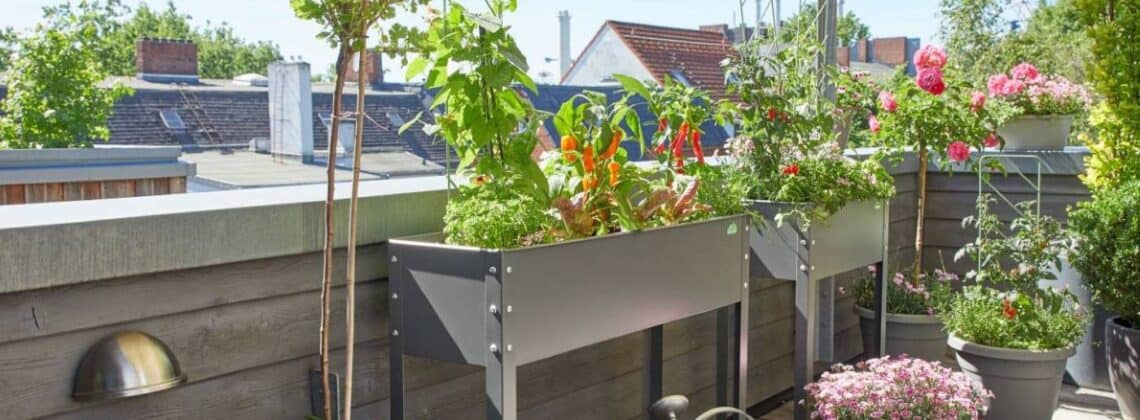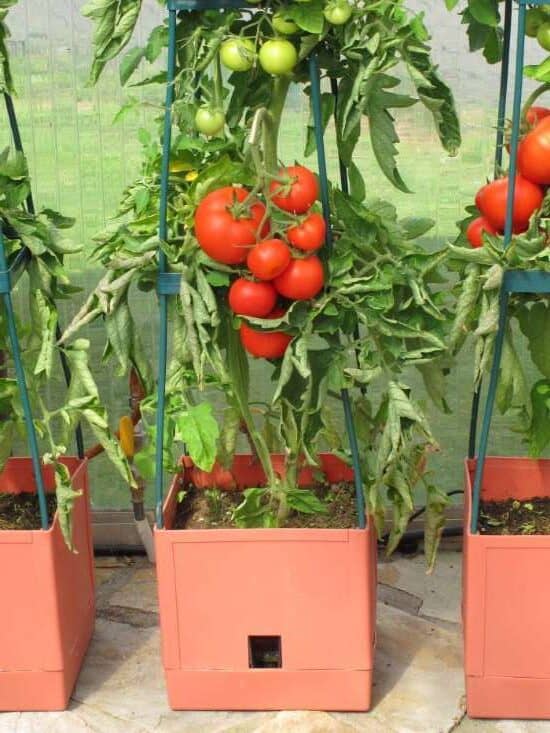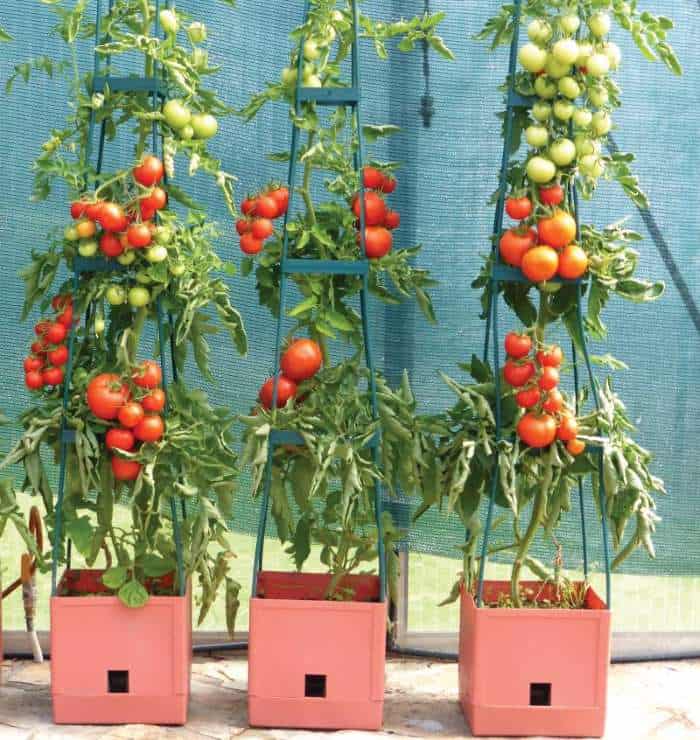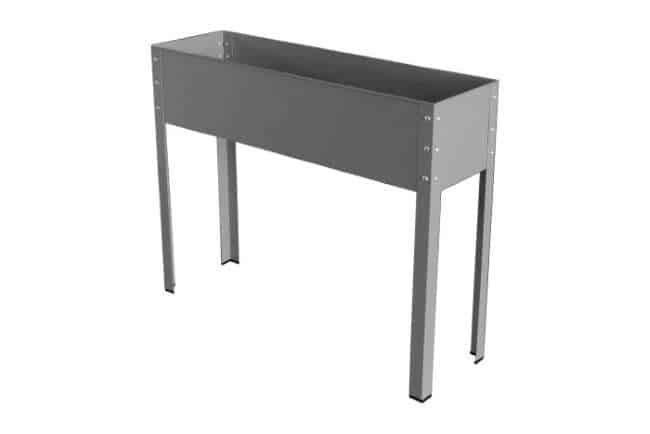
It’s easier than ever to grow tomatoes in containers. Here’s how.
Tomatoes are the queens of the backyard vegetable garden, and growing vegetables is more popular than ever. But not everyone has a backyard with lots of space for an impressive garden plot.
Fortunately, most flowers and many vegetables can be grown in containers. This makes growing vegetables such as tomatoes, squash, peppers, salad greens, and all types of flowers possible on decks, balconies, and other small spaces.
Thanks to new types of growing containers and new dwarf varieties of popular plants, virtually anyone can successfully grow a fabulous garden.
Quick Tips on Container Gardening
There are a few important things to know about how to grow tomatoes in containers (or any kind of plant). Even before you select the pots or containers for your plants, pick the best location for your container garden.
Tomato plants (and most vegetable plants) like at least 6 hours of full sun a day. So, pick a sunny location rather than a shady spot.
If possible, place your containers close to a water source. When growing plants on a patio or deck, it’s best if your garden is within the reach of a water hose. If you’re growing plants on a balcony, you will probably need to bring water from inside. Get a large watering can so you won’t have to make too many trips.
One more thing about location. A spot right next to a wall that gets full afternoon sun is not ideal. Container-grown plants can get too hot in the sun.
If the only spot available is near a hot, sunny wall, you may need to use shade cloth to keep your plants from getting cooked.
A Fast Fact About Tomato Plants
There are two major types of tomato plants: indeterminate and determinate. Indeterminate plants keep getting bigger and bigger all summer long, while determinate plants grow to a certain size and stop.
For that reason, only determinate tomato varieties can be successfully grown in small containers. If you want to grow indeterminate tomatoes in your container garden, grow them in a large container, such as the containers we describe below. Also, if you grow indeterminate tomatoes, you will need a trellis for the vines to grow on.
How to Grow Tomatoes in Containers: Choosing the Perfect Container
When it comes to pots and growing containers for plants, size matters. One mistake that beginning gardeners make is choosing pots and containers that are too small. The tomato starter plant that you buy at a garden center is going to get MUCH, MUCH bigger by the end of the summer. So, don’t buy a container based on the size of the starter plant. Buy a container that’s big enough to accommodate the size of the MATURE plant.
The old-fashioned terracotta or ceramic pots are fine for growing single small plants such flowers and herbs. Make sure these pots have a drainage hole in the bottom. And make sure to buy a plant saucer to catch the extra water that passes through the potting soil.
However, container gardening has come a long way recently. That’s because of the amazing new self-watering containers that are now available. These new growing containers put the old clay pots and five-gallon pots to shame. For the best patio, porch, or balcony garden, we recommend growing in new self-watering containers.
Self-irrigated containers have a built-in water reservoir and the bottom of the container. The water stored in the reservoir is wicked back up into the potting soil. That keeps plants comfortably moist, makes it easy and efficient to grow tomatoes in containers for the first time. Of course, you can grow all kinds of plants in a self-watering container, including carrots, beans, cucumbers, bell peppers, and zucchini. Or flowers and herbs.
But self-watering containers are particularly well suited for plants that like to grow in consistently moist soil—like tomatoes.
New Self-Watering Containers
As we just mentioned, the newest type of container is called a “self-watering” container. This high-tech approach to growing plants takes advantage of the “capillary action” of soil and potting mix. Water is added to the reservoir at the bottom of the container. Then the water gets wicked up into the potting mix, where it can thoroughly hydrate the plant roots growing in the container.
One of newest self-irrigated growing containers is the Maxitom Plant Tower from Biogreen. The Maxitom was specifically designed to grow a single tomato plant in the smallest “footprint” possible. This ingenious container measures about 1 foot by 1 foot, so it fits perfectly on a small balcony, terrace, porch, and other urban or suburban space.
The Maxitom planter holds about 16 liters of potting mix. This gives plenty of growing space for a large tomato plant or other vegetable plants including pole beans, cucumbers, and other climbing plants. The integrated water reservoir holds 2 liters of water. The water reservoir ensures the plant will get a steady supply of water, even in the heat of the summer. This steady water helps to prevent tomato blossom end rot.
The Maxitom Tower has four trellis levels that can be added individually. Just add one at a time as your plant grows taller. The stable, weather-resistant construction gives your plant the necessary support it requires. The Maxitom Plant Tower is available in two colors: terracotta and anthracite.
Grow Tomatoes in Containers: City Jungle Planter
Also available is the popular City Jungle self-irrigated container. The City Jungle uses German engineering and design to provide the perfect growing conditions for tomato plants and other vegetables. The container is about one foot wide and two feet long. These two square feet of planting space is perfect for two mature tomato plants. The container is about a foot deep, so it holds an impressive 9.0 gallons (34 liters) of potting soil.
The water reservoir of the City Garden container holds 4.5 gallons. That means, in most settings and most climates, with a full reservoir plants can go for several days without additional water. When plants need more water, just add water to the reservoir with a watering can or hose. The handy hole in the front wall of the City Jungle makes adding water quick and easy.
The City Garden looks great on balconies, terraces, decks, porches, and even rooftop gardens. With this planter, even the smallest sunny urban or suburban space can be turned into a lush, productive vegetable or flower garden.
For taller plants such as tomatoes, a sturdy trellis can be added. The City Jungle Trellis provides plenty of support for tomatoes, cucumbers, beans, peas and most tall or vining plants. City Jungle products are available from Amazon.
Use Elevated Garden Beds to Grow Tomatoes in Containers
Container gardening with elevated garden beds is another good choice for patio and deck gardening. Elevated garden containers, such as the Freising Elevated GardenBeds from Biogreen, can be a great choice for those who appreciate “back-friendly” gardening.
An elevated garden bed brings the plants up to waist level, so there’s no bending or straining to get to your plants. A Freising Elevated Garden Bed is made of tough galvanized, powder-coated steel. Its sturdy construction makes this elevated container rustproof and strong enough to withstand years of outdoor use. Drainage holes automatically drain off excess water, ensuring healthy plants.
The Freising L model measures 2 feet by 1 foot, offering two square feet of planting space for flowers, herbs, and small vegetables such as salad greens. The larger Freising XL planter is 3.2 feet long for even more planting space.
The Raised Garden Bed “Heidelburg” container combines the best of elevated and self-watering containers. This unique elevated growing container includes a self-watering system similar to the City Jungle container. The water reservoir holds 2.6 gallons of water, which automatically wicks up through the potting mix.
The City Jungle Heidelberg is made of tough powder-coated steel so it won’t rust. An optional trellis and cover are also available.
With all of these new options available, it’s easier than ever to grow tomatoes in containers. And any other plants you want to grow!
But Wait, There’s More
For additional information about vegetable varieties that will grow well in container gardens, read Top 10 Vegetables for Container Gardening. You’ll also enjoy Best New Vegetable Seeds and Plants for Your Garden.







Leave a Reply